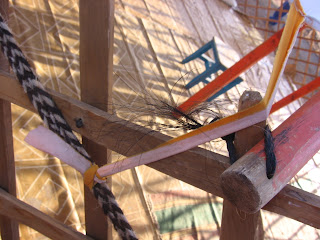Cyrillic
|
дүү
|
|
Transcription
|
düü
| |
IPA
|
[tʉ:]
| |
Layman’s
Pronunciation
|
DOOH
| |
Translation
|
younger sibling;
younger
| |
In Genghis Khan’s time it was degüü.
| ||
By my calculations I owe you three words of the week. Continuing
with the theme of words that make distinctions English doesn’t, this day’s
(week’s?) word is дүү.
There’s probably no better word to begin talking about the
differences between traditional Mongolian and English-speaking families. Дүү does not correspond in a one-way
relationship to any English word for a relative, because it can refer to either
a younger brother, or a younger sister. Mongolian does not have separate words
for them. However, it never refers to an older
brother (ах) or an older
sister (эгч). Basically, дүү is a word that classifies relatives by
their age, not their gender.
Of course Mongolians can be specific if they want. If they want to be
more specific they can call a younger brother эрэгтэй дүү
or бүстэй дүү
and call a younger sister эмэгтэй дүү or бүсгүй
дүү. English speakers can also add “younger” or “older” to the
words “brother” or “sister” if they want to talk about how old they are. The
point is that English speakers have to specify gender when they talk about
siblings, but they don’t have to specify age, and that Mongolians have to
specify age, but they don’t have to specify gender (at least for younger
siblings).
This is part of a bigger
pattern. English words for relatives usually indicate the gender of the
relative (except “cousin”). They don’t distinguish the ages of people in the same generation. Mongolians words
for relatives don’t always distinguish the gender of the relative, but many of
them distinguish whether relatives in the same generation are older or younger.
For example, in addition to the words for siblings, Mongolian also has
different words for one’s aunts and uncles, depending on whether they’re older
or younger than one’s mother or father.
Perhaps in Mongolian culture
age is just a bigger deal than it is in America. Perhaps it has to do with the
fact that older children often participate in the family’s work, including
acting as a caretaker for younger children. Children of different ages really
aren’t considered the same or equal. I do know that in my сум (county), children of
rural nomadic families usually have to live in a dormitory during the school
year. Students are grouped in dorm rooms primarily by who is related to whom.
For most of the year school children don’t live with their parents, but they do
live with their older brothers and sisters, who are then responsible for their дүү нар (that’s the plural of дүү). Of course
this doesn’t apply to the hundreds of years before Mongolians had
primary-school education. I don’t really know the reason, but I do know there
is some deeply ingrained social reason that Mongolians feel that the age of
relatives is essential information, but Anglophones don’t.
She’s
дүү-er than me
Дүү refers to age in a more general sense
because people use it to talk about who’s older or younger, even when they
aren’t related to each other. To say that someone is younger than you, you
would say something like,
Тэр надаас дөрвөн нас дүү.
She-NOMINATIVE me.ABLATIVE four year
younger-sibling
“She is four years younger than me.”
using the word for younger sibling. It could be rendered into English as
“She is my younger sister by four years,” but “she” doesn’t have to be related
to the speaker at all in order to say this. Here, it simply means, “She is four
years younger than me.”
Confusion
If the different way of talking about relatives confuses you, don’t
worry, it confuses Mongolians too. Mongolian schoolchildren seem to have been
taught that English “brother” is equivalent to Mongolian ах (older brother) and English “sister” is equivalent to Mongolian эгч
(older sister). They also know that “younger brother” and “younger sister” both
mean дүү. However, it’s never pointed out that Mongolian and Western
notions of family are different, or how. Many of them don’t realize that
“younger” is a separate word that describes “brother” or “sister” and is
completely optional. This means that whenever I talk to Mongolians, they almost
always tell me that a younger brother is a “younger
brother.” For the rest of the conversation, they will continue to use the full
phrase “younger brother,” even though I knew long ago that he was younger.
In fact, many of them don’t realize that a “younger brother”
is still a kind of brother and that a “younger sister” is still a kind of sister.
This means that (no joke) I have also had conversations like this:
Me: Do
you have a brother?
Student: No,
I do not have a brother. But I have two younger brothers.
Me: ???
I really think these kids need to learn more about culture, not just
memorizing vocabulary and grammar rules.












































